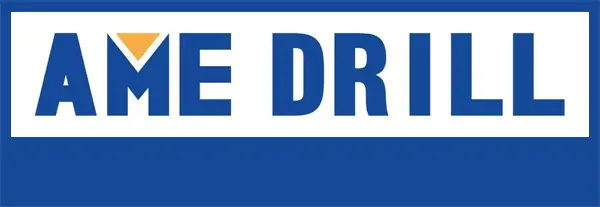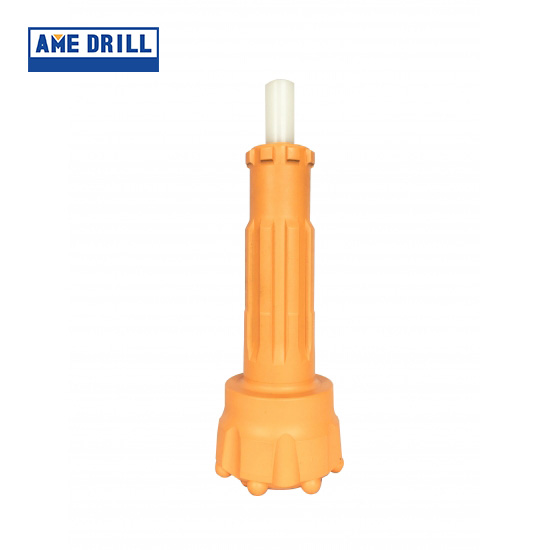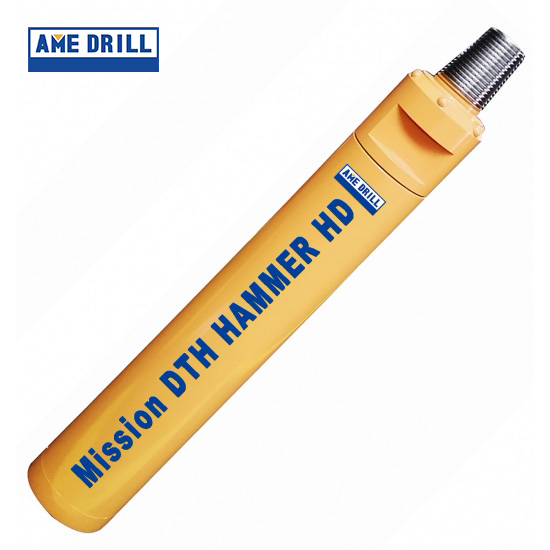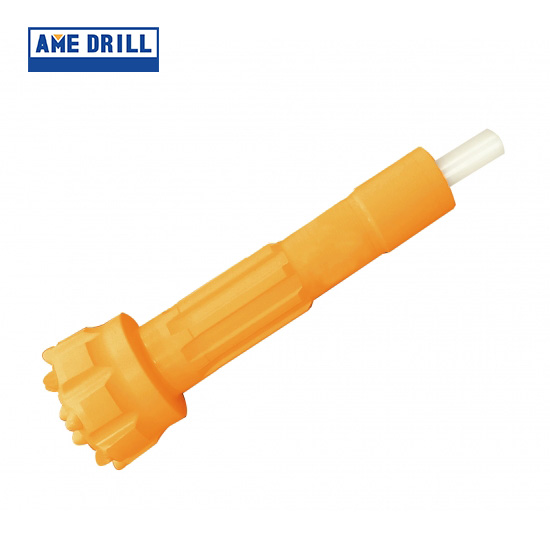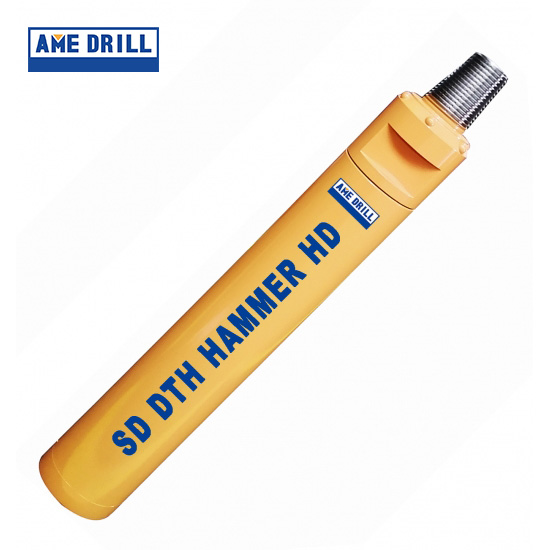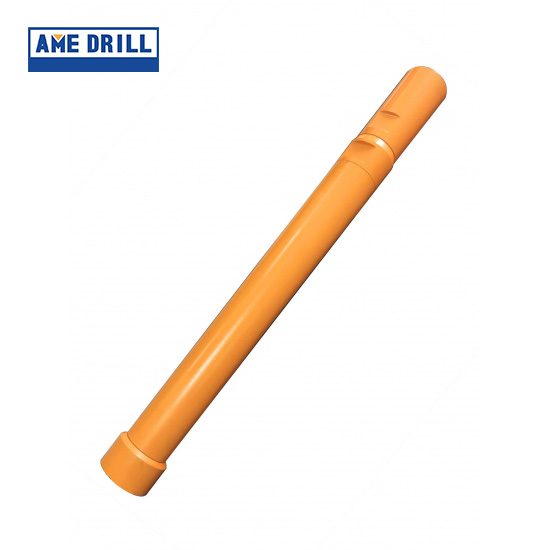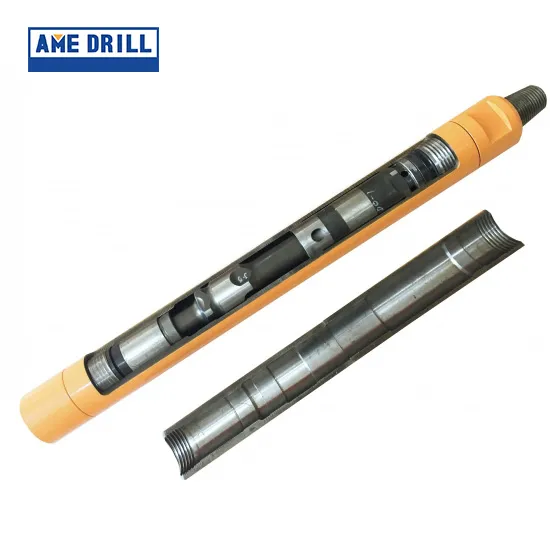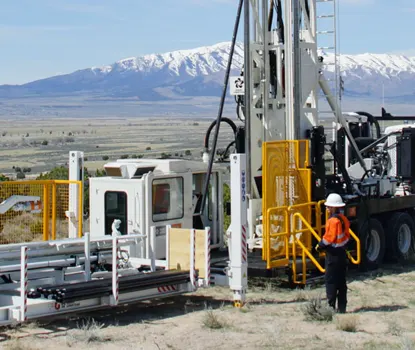Understanding the distinct drilling mechanisms of DTH (Down-The-Hole) and Top Hammer rigs is crucial for optimizing your drilling operations. Both methods are widely employed across various industries, from mining to construction, yet they differ fundamentally in how they deliver percussive energy to the rock. This blog post will delve into their core operational principles and key differentiating factors.
We will explore how DTH hammers generate impact at the bottom of the hole, close to the drill bit, leading to specific advantages in certain geological conditions. Conversely, we will examine how Top Hammer drills transmit impact energy from the surface, through the drill string. By understanding these differences, you can make informed decisions to select the most efficient and cost-effective drilling method for your project’s unique requirements.
What are DTH Hammers
Marteaux DTH recommandés
A DTH (Down-The-Hole) hammer is a powerful percussion drilling tool used across various industries, including mining, construction, and water well drilling. It operates by delivering rapid, high-energy impacts directly to a drill bit, effectively breaking rock into small chips.
Unlike top hammer drills where the striking mechanism is at the surface, the DTH hammer is located at the bottom of the drill string, right behind the bit, which ensures highly efficient energy transfer and minimizes power loss, making it particularly effective for drilling straight holes in hard and abrasive rock formations.
The hammer’s internal piston is actuated by compressed air, striking an anvil that transmits the force to the drill bit, while the exhaust air flushes cuttings from the borehole.
DTH Hammer Uses
DTH (Down-The-Hole) hammers are versatile tools employed across a wide array of industries due to their efficiency in penetrating hard rock formations. Their ability to deliver powerful, direct impacts at the bottom of the hole makes them indispensable for various drilling applications, including:
- Exploitation minière : Used extensively for blast hole drilling in open-pit and underground mines, creating boreholes for explosives to break up ore and rock.
- Construction : Essential for foundation drilling, piling, and pre-splitting in infrastructure projects, ensuring stable bases for buildings, bridges, and roads.
- Forage de puits d'eau : Highly effective in boring through various rock strata to access groundwater, providing reliable water sources for communities and agriculture.
- Exploitation de carrières : Employed for dimension stone quarrying and aggregate production, enabling the extraction of valuable rock materials efficiently.
- Forage géotechnique et d'exploration : Utilized for core sampling and creating boreholes for geological surveys, providing critical data on subsurface conditions for engineering and resource assessment.
What are Top Hammers
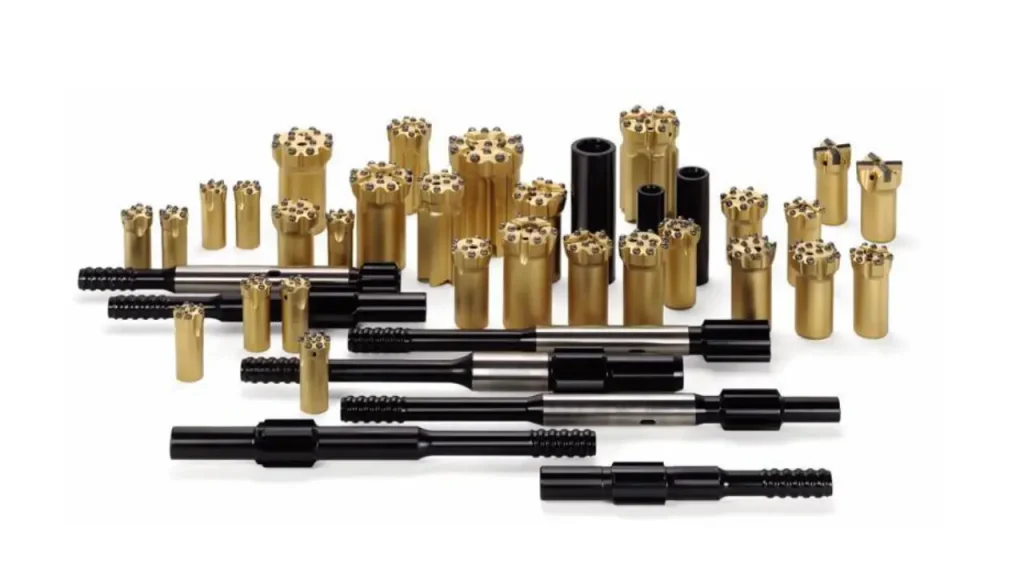
A Top Hammer, also known as a drifter or surface percussion drill, is a drilling method where the percussion mechanism is located on the drill rig, above the surface.
Unlike DTH hammers, the impact energy generated by the top hammer is transmitted down the drill string through threaded drill rods to the drill bit.
This method is highly versatile and commonly used for smaller diameter holes, shorter depths, and in applications like construction, quarrying, and foundation drilling where mobility and adaptability to varying rock conditions are priorities. While it may experience greater energy loss over longer drill strings compared to DTH, its flexibility and ease of operation make it a preferred choice for many surface drilling projects.
Top Hammer Uses
Top Hammer drills are highly adaptable tools utilized in numerous applications where their versatility and mobility are advantageous. Their percussive mechanism, located on the surface, allows for flexibility in various ground conditions and project sizes, making them a common sight in:
- Construction : Widely used for general construction projects, including site preparation, trenching, and utility installations, where smaller holes and frequent rig moves are common.
- Exploitation de carrières : Employed for bench drilling in aggregate quarries and dimension stone operations, where precise hole patterns and controlled blasting are essential for material extraction.
- Construction de routes : Crucial for rock excavation in road building, enabling the creation of stable roadbeds and cuttings through challenging terrain.
- Foundations and Piling: Used for drilling anchor holes, micropiles, and small-diameter foundations, providing stability for structures in various ground conditions.
- Exploration and Geotechnical Drilling: Applied in shallow exploration programs and geotechnical investigations, where samples are needed at moderate depths to assess ground properties.
DTH vs Top Hammer

Understanding the core differences between DTH and Top Hammer drilling is essential for selecting the optimal method for your project. This comparison will highlight key distinctions in their operation, application, and overall performance characteristics.
Mécanisme de transfert d'énergie
En DTH (Down-The-Hole) drilling, the percussion mechanism is located directly at the bottom of the borehole, inside the hammer. The compressed air drives a piston within the hammer, which directly strikes the drill bit. This direct transfer minimizes energy loss, making DTH highly efficient for deep holes and hard rock formations, as the impact energy is delivered precisely where it’s needed.
Conversely, Top Hammer drilling transmits impact energy from a percussive unit located on the surface, down the drill string to the bit. The energy travels through drill rods, which are threaded together. This indirect transfer can lead to significant energy losses over longer drill strings, especially in deeper holes, potentially reducing penetration rates in very hard rock compared to DTH.
Rectitude du trou
DTH hammers are renowned for producing exceptionally straight holes, even in challenging ground conditions. Because the hammer is at the bottom of the hole, it acts as a guide, inherently helping to maintain the bore’s trajectory. This characteristic is particularly beneficial for applications requiring precise hole alignment, such as foundation drilling or blast hole patterns.
Top Hammer drilling can sometimes result in less straight holes, especially in uneven or fractured ground. The energy transfer through flexible drill rods can allow for more deviation, as the bit is not rigidly guided by the hammering unit at the bottom. While techniques exist to mitigate this, DTH generally offers superior hole straightness.
Capacité de profondeur
DTH hammers are ideally suited for drilling deep holes. The direct energy transfer mechanism means that drilling deeper does not significantly diminish the impact energy delivered to the bit. This makes DTH the preferred choice for applications like deep water wells, large-scale mining operations, and geotechnical investigations requiring significant depth.
Top Hammer drills are generally more suitable for shallower holes. As hole depth increases, the number of drill rods required also increases, leading to greater energy loss and reduced efficiency. While they can drill to moderate depths, their performance significantly decreases compared to DTH hammers for very deep applications.
Drill Bit Life
DTH drilling often leads to longer foret life, particularly in abrasive or hard rock conditions. The high-frequency, direct impact action combined with efficient flushing clears cuttings effectively, reducing bit wear from regrinding. The controlled energy delivery also minimizes shock loads on the bit inserts.
Top Hammer drilling can sometimes lead to faster wear on drill bits, especially in hard or abrasive rock. The indirect energy transfer and potential for more erratic bit action can cause increased stress and abrasion on the bit inserts. Additionally, less efficient flushing in some cases can contribute to faster bit wear.
Noise Levels
DTH hammers generally produce less noise at the surface compared to top hammer drills. Since the percussion mechanism is located down in the borehole, much of the operational noise is muffled by the surrounding rock. This can be a significant advantage in urban environments or other noise-sensitive areas.
Top Hammer drills, with their percussive unit located at the surface, typically generate higher noise levels. The hammering action is exposed, leading to more airborne noise during operation. This often necessitates stricter noise control measures or limits on operating hours in residential or environmentally sensitive locations.
Here are the differences between DTH hammer and top hammers in the following:
| Aspect | Marteau DTH | Top Hammer |
| Energy Transfer | Direct (hammer at hole bottom) | Indirect (hammer at surface, via rods) |
| Rectitude du trou | Excellent | Good to moderate (can deviate) |
| Capacité de profondeur | Suited for deep holes | Suited for shallower to moderate holes |
| Drill Bit Life | Generally longer | Can be shorter (depending on conditions) |
| Noise Levels | Lower (muffled by ground) | Higher (percussion at surface) |
Top Hammer Drilling vs Down the Hole Drilling
Understanding the fundamental operational differences between DTH (Down-The-Hole) and Top Hammer drilling methods is crucial for optimizing project efficiency. This comparison delves into their distinct mechanics, suitability for various conditions, and overall performance characteristics, guiding optimal equipment selection.
Mécanisme de transfert d'énergie
In DTH drilling, the percussive hammer is located directly at the bottom of the borehole, striking the drill bit from within. Compressed air powers a piston inside the hammer, transmitting energy directly to the rock. This direct impact minimizes energy loss as depth increases, ensuring consistent power for efficient rock breaking at any depth.
À l'inverse, le forage au marteau-pilon fait appel à une unité de percussion montée sur l'appareil de forage à la surface. L'énergie d'impact est transmise au trépan par l'intermédiaire d'une série de tiges filetées. Ce transfert indirect d'énergie signifie que la puissance peut diminuer avec l'augmentation de la longueur du train de tiges, ce qui affecte l'efficacité dans les trous plus profonds.
Rectitude du trou
Les marteaux DTH sont réputés pour leur capacité à produire des trous exceptionnellement droits, même dans des formations rocheuses difficiles et variables. La position du marteau au fond du trou agit comme un stabilisateur naturel, guidant le trépan et minimisant la déviation. Cette précision est essentielle pour les applications nécessitant un alignement strict du trou de forage, comme les travaux de fondation.
Le forage au marteau-pilon, en raison de l'énergie transmise par des tiges flexibles, peut parfois entraîner une plus grande déviation du trou, en particulier dans les sols fracturés ou sur des longueurs de forage plus importantes. Bien que des opérateurs qualifiés puissent atténuer ce phénomène, le maintien d'une rectitude parfaite peut s'avérer plus difficile que la stabilité inhérente offerte par le forage au marteau-piqueur.
Capacité de profondeur
Le forage DTH est la méthode préférée pour les trous profonds, dépassant souvent des centaines de mètres. Le mécanisme d'impact direct garantit que l'efficacité de l'action de percussion est maintenue quelle que soit la profondeur. Le DTH est donc très efficace pour l'exploitation minière à grande échelle, les puits d'eau profonds et les études géotechniques approfondies.
Le forage au marteau-pilon est généralement plus adapté aux trous peu profonds, généralement jusqu'à 20-30 mètres, bien que cela puisse varier. À mesure que la profondeur augmente, la perte d'énergie à travers le train de tiges plus long devient plus prononcée, ce qui entraîne une réduction des taux de pénétration et de l'efficacité. Sa force réside dans la rapidité de mise en œuvre pour les profondeurs moins exigeantes.
Usure et longévité des embouts
Le forage DTH permet généralement de prolonger la durée de vie du trépan, en particulier dans les roches très dures et abrasives. Le système de rinçage efficace, associé à l'impact direct et constant, réduit le risque de réaffûtage des déblais. L'usure des plaquettes en carbure est ainsi minimisée, ce qui permet d'allonger les intervalles de service et de réduire les coûts des consommables.
Le forage au marteau-pilon peut, dans certaines conditions, entraîner une usure plus rapide du trépan. Le transfert indirect d'énergie peut entraîner un mouvement plus irrégulier du trépan et une augmentation des contraintes sur les éléments de coupe. L'élimination moins efficace des déblais dans certaines applications peut également contribuer à l'usure abrasive, ce qui nécessite des changements de trépan plus fréquents.
Bruit et vibrations
Les marteaux DTH produisent généralement des niveaux de bruit plus faibles à la surface. Comme l'action de percussion primaire se produit en profondeur dans le trou de forage, une grande partie du son est absorbée et étouffée par la roche environnante et les morts-terrains. Le DTH est donc une option plus respectueuse de l'environnement pour les zones sensibles au bruit ou les projets urbains.
Les marteaux perforateurs ont tendance à générer des niveaux de bruit et de vibration plus élevés à la surface. Le mécanisme de percussion exposé sur l'appareil de forage produit un son important qui se propage facilement. Cela nécessite souvent des mesures strictes de contrôle du bruit, ce qui peut avoir un impact sur les heures d'exploitation ou nécessiter des équipements d'atténuation du bruit supplémentaires dans les zones peuplées.
Focus sur l'application
Le forage DTH excelle dans les applications nécessitant des taux de pénétration élevés dans des roches très dures et compétentes, et lorsque des trous rectilignes de grand diamètre sont essentiels. Son objectif principal est de maximiser l'efficacité du forage et de réaliser des trous précis dans des conditions géologiques difficiles, ce qui en fait un outil idéal pour l'exploitation minière en profondeur et les grands travaux de construction.
Le forage au marteau-pilon offre une plus grande polyvalence pour les projets présentant des conditions rocheuses variées, des diamètres de trou plus petits et des déplacements fréquents entre les points de forage. Il est souvent choisi pour des applications de surface telles que la construction générale, la construction de routes et l'exploitation de carrières, où la rapidité d'installation, la mobilité et l'adaptabilité aux changements de terrain sont des priorités essentielles.
Here are the differences between DTH drilling and top hammer drilling:
| Aspect | Forage DTH | Top Hammer Drilling |
| Energy Transfer | Direct (hammer at hole bottom) | Indirect (hammer at surface, via rods) |
| Rectitude du trou | Excellent, inherent guidance | Good, can be prone to deviation |
| Capacité de profondeur | Ideal for deep holes (consistent efficiency) | Suited for shallower to moderate depths |
| Bit Wear & Longevity | Generally longer bit life, less regrinding | Can be faster bit wear, more abrasive action |
| Noise & Vibration | Lower surface noise (muffled by ground) | Higher surface noise and vibration |
| Focus sur l'application | Hard rock, deep, straight, large holes | Varied rock, shallower, mobile, small-medium holes |
How to Choose DTH and Top Hammers
Choosing between DTH (Down-The-Hole) and Top Hammer les méthodes de forage requires careful consideration of several factors to ensure optimal efficiency and cost-effectiveness for your project. The decision hinges on understanding the specific demands of your application and the characteristics of the drilling environment.
Here are key aspects to consider when selecting between DTH and Top Hammer:
Conditions géologiques :
- DTH: Ideal for very hard, abrasive rock formations where direct impact energy is most effective for penetration. It handles fractured or variable ground well due to constant bit-to-hammer contact, reducing energy loss.
- Top Hammer: Better suited for softer to medium-hard rock, or when drilling through varying strata with frequent changes. Its versatility allows for quick adjustments in different ground conditions.
Hole Depth and Diameter:
- DTH: Preferred for deep holes (over 20-30 meters) and larger diameters (typically 90mm and above). The direct energy transfer remains efficient even at great depths, ensuring consistent performance.
- Top Hammer: More effective for shallower holes (under 20-30 meters) and smaller to medium diameters. Energy loss increases with depth due to rods, limiting its efficiency for very deep applications.
Required Hole Straightness:
- DTH: Delivers superior hole straightness due to the hammer’s guiding action at the bottom of the hole. This is crucial for precision blasting, foundation piling, or any application requiring accurate bore alignment.
- Top Hammer: Can experience more deviation, especially in challenging ground or at greater depths, as the rods can flex. While good for general applications, it might not meet strict straightness requirements.
Mobility and Site Setup:
- DTH: Often requires larger, heavier rigs due to the need for higher air compression and larger drill string components. Setup can be more involved, but once operational, it’s highly efficient for its niche.
- Top Hammer: Generally uses lighter, more mobile rigs that are quicker to set up and move between drilling locations. This makes it ideal for sites with frequent relocations or restricted access.
Environmental Considerations (Noise):
- DTH: Typically produces less surface noise as the percussive action occurs downhole, muffling the sound. This is an advantage in urban areas or environmentally sensitive sites with strict noise regulations.
- Top Hammer: Generates more significant surface noise due to the exposed hammering mechanism. Noise reduction measures might be necessary in populated areas, impacting operational flexibility.
Conclusion
In conclusion, both DTH and Top Hammer drilling methods offer distinct advantages, making them suitable for different applications. DTH excels in deeper holes and harder rock formations due to its efficient energy transfer at the bit, leading to straighter holes and often faster penetration in challenging conditions. Top Hammer, on the other hand, provides versatility and control, particularly in smaller diameter holes and varied ground conditions, often favored for its mobility and ease of use in diverse surface applications.
Choosing between DTH and Top Hammer ultimately depends on your project’s specific requirements, including geological conditions, hole depth, required diameter, and overall budget. Understanding their fundamental operational differences in energy transmission and hole cleaning is key to selecting the most efficient and cost-effective drilling solution for your needs.
For reliable and high-performance DTH hammers, consider Ame Drill. As a trusted supplier, Ame Drill offers a wide range of wholesale DTH hammers designed for durability and efficiency across various drilling applications. Partner with Ame Drill for your DTH drilling needs and optimize your project’s productivity.
